seat adjustment AUDI TT ROADSTER 2011 Owners Manual
[x] Cancel search | Manufacturer: AUDI, Model Year: 2011, Model line: TT ROADSTER, Model: AUDI TT ROADSTER 2011Pages: 260, PDF Size: 64.11 MB
Page 68 of 260

66 Seat s a nd s tor ag e
Seats and storage
General recommen
dations
Why is your seat adjustment so
important?
The safety belts and the airbag system can
only provide maximum protection if the front
seats are correctly adjusted.
There are various ways of adjust ing the front
seats to provide safe and comfortable support
for the driver and the front passenger . Adjust
your seat properly so that :
- you can easily and quick ly reach all the
switches and controls in the instrument
panel
-your body is prope rly supported thus reduc
ing physical stress and fatigue
- the safety be lts and airbag system can offe r
maximum protection
¢ page 115 .
In the following sec tions, you will see exactly
how you can best adjust you r seats .
There are special regulations and instructions
for insta lling a child safety seat on the front
passenger's seat. Always heed the informa
tion rega rd ing child safety provided in
¢ page 136, Child Safety .
A WARNING
Incorrect seating position of the driver and
all other passengers can result in serious
personal injury.
- Always keep your feet on the floor when
the vehicle is in motion -never p ut your
feet on top of the instrument panel, out
of the w indow or on top of the seat cush
ion! This applies espec ially to the passen
gers .
If your seating position is incorrect
you increase the r isk of injury in the case
of sudden braking or an acc ident.
If the
airbag infla tes and the seating position
is incorrect this could result in personal
injury or even death.
- It is import ant for bo th the driver and
front passenger to keep a distance of at least 10 inches (25 cm) between them
selves and the steering wheel and/or in
strument panel. If you're s itting any
closer than th is, the a irbag system can
not protect you properly . In addition to
this, the front seats and head restra ints
must be adjusted to your body height so
that they can give you max imum protec
tion.
- Always try to keep as much distance as
possible between yourself and the s teer
ing wheel or instrument pane l.
- Do not adjust the driver's o r fron t pa s
senger's seat whi le the vehicle is moving.
Your seat may move unexpected ly, caus
ing sudden loss of vehicle contro l and
personal injury . If you ad just yo ur seat
while the veh icle is moving, you are out
of posit ion.
Driver's seat
The correct seat position is important for safe
and relaxed driving.
We recommend that you adjust the driver's
seat in the fo llowing manner:
.,. Adjust the seat in fo re and aft direction so
t ha t you can easily p ush the peda ls to the
floor wh ile keeping your knee slightly bent
i::> A in Why is your seat adjustment so im
portant? on page
66 .
.,. Adjust the seatback so that when you sit
w ith your back against the seatback, you can
still grasp the top of the steering wheel.
.,. Posit io n the head restraint according to the
occupant 's height
<=:>page 70 . For maxi
mum protection, t he top of the head re
s t raint shou ld be a t least at eye level, pref
erab ly higher and idea lly level with the top
of the head
¢ page 101, fig. 109 .
A WARNING "--
Never place any objects in the dr iver's foot-
well. An object could get into the pedal
area and interfere with pedal function. In
case of sudden braking or an acc ident, you
wo uld not be able to brake or accelerate!
Page 69 of 260
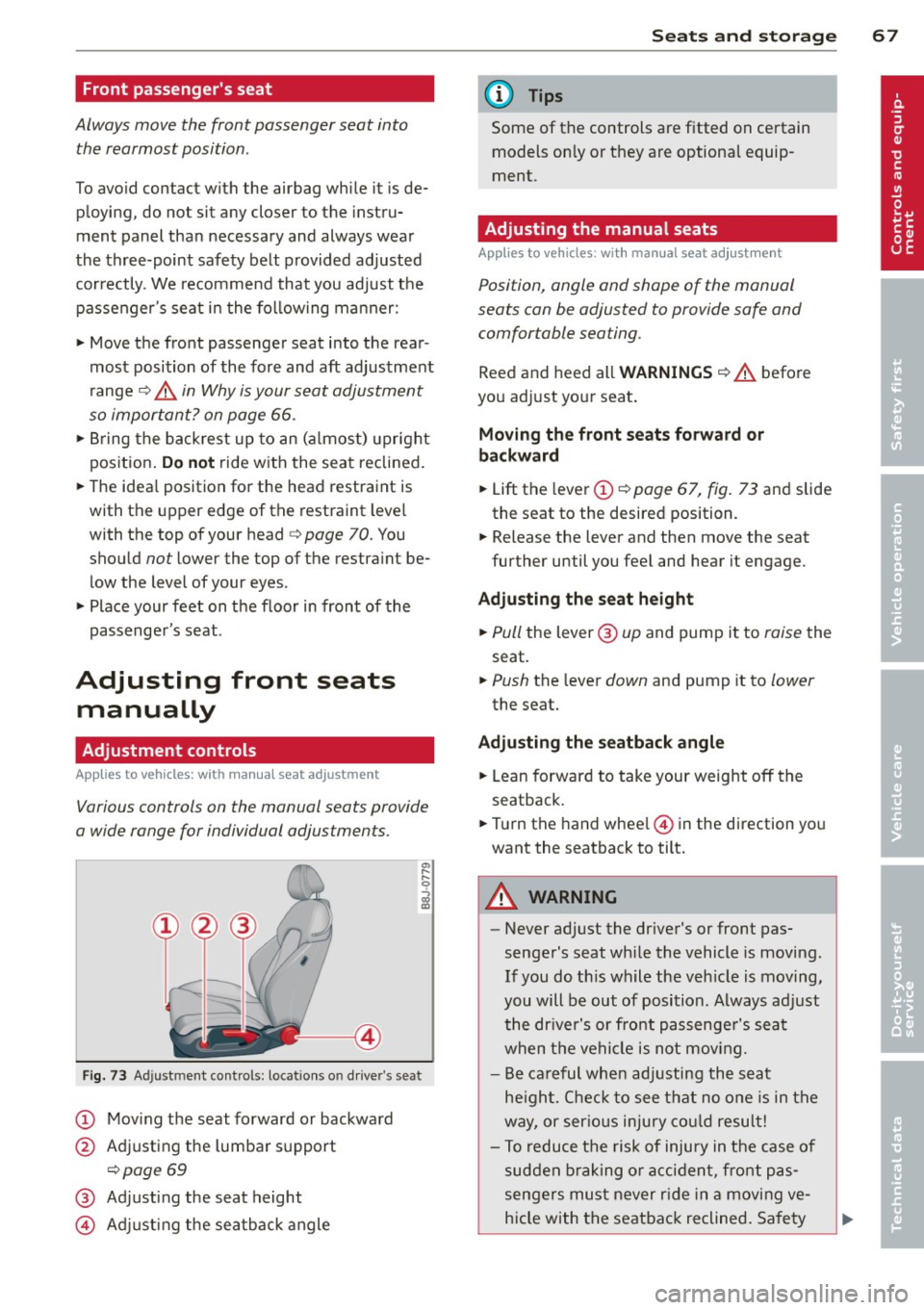
Front passenger's seat
Always move the front passenger seat into the rearmost position .
To avoid contact with the airbag while it is de
p loying, do not sit any closer to the instru
ment panel than necessary and always wear
the three-point safety belt provided adjusted
correctly . We recommend that you adjust the
passenger's seat in the following manner:
.,. Move the front passenger seat into the rear
most position of the fore and aft adjustment
range
c:::> &. in Why is your seat adjustment
so important? on page
66.
.,. Bring the backrest up to an (almost) upright
position.
Do not ride with the seat reclined .
.,. The idea l position for the head restraint is
with the upper edge of the restraint leve l
with the top of your head
c:::> page 70. You
shou ld
not lower the top of the restra int be
low the level of your eyes .
.,. Place your feet on the floor in front of the
passenge r's seat .
Adjusting front seats
manually
Adjustment controls
App lies to vehicles: with manual seat adjustment
Various controls on the manual seats provide
a wide range for individual adjustments .
Fig. 73 Adjustment contro ls: loca tions o n dr iver's seat
CD Moving the seat forward or backward
@ Adjusting the lumbar support
c:::> page 69
@ Adjusting the seat height
© Adjusting the seatback angle
Seats and storage 67
(D Tips
Some of the controls are fitted on certain
models on ly or they are optional equip
ment .
Adjusting the manual seats
Applies to vehicles : wit h manual seat adjustment
Position, angle and shape of the manual
seats can be adjusted to provide safe and
comfortable seating .
Reed and heed all WARNINGS c:::> A before
you adjust your seat .
Moving the front seats forward or
backward
... Lift the lever CD c:::> page 67, fig. 73 and slide
the seat to the desired position.
.,. Release the lever and then move the seat
further until you feel and hear it engage.
Adjusting the seat height
.,. Pull the lever @ up and pump it to raise the
seat.
... Push the lever down and pump it to lower
the seat.
Adjusting the seatback angle
.,. Lean forward to take your weight off the
seatback.
... Turn the hand wheel © in the direction yo u
want the seatback to tilt.
A WARNING
-
- Never adjust the driver's or front pas
senger's seat whi le the vehicle is moving.
If you do th is while the vehicle is moving,
you will be out of position. Always adjust
the driver's or front passenger's seat
when the vehicle is not moving.
- Be careful when adjusting the seat
height. Check to see that no one is in the
way, or serious injury could result!
- To reduce the risk of injury in the case of
sudden braking or accident, front pas
sengers must never rid e in a moving ve
hicle with the seatback reclined . Safety
Page 70 of 260
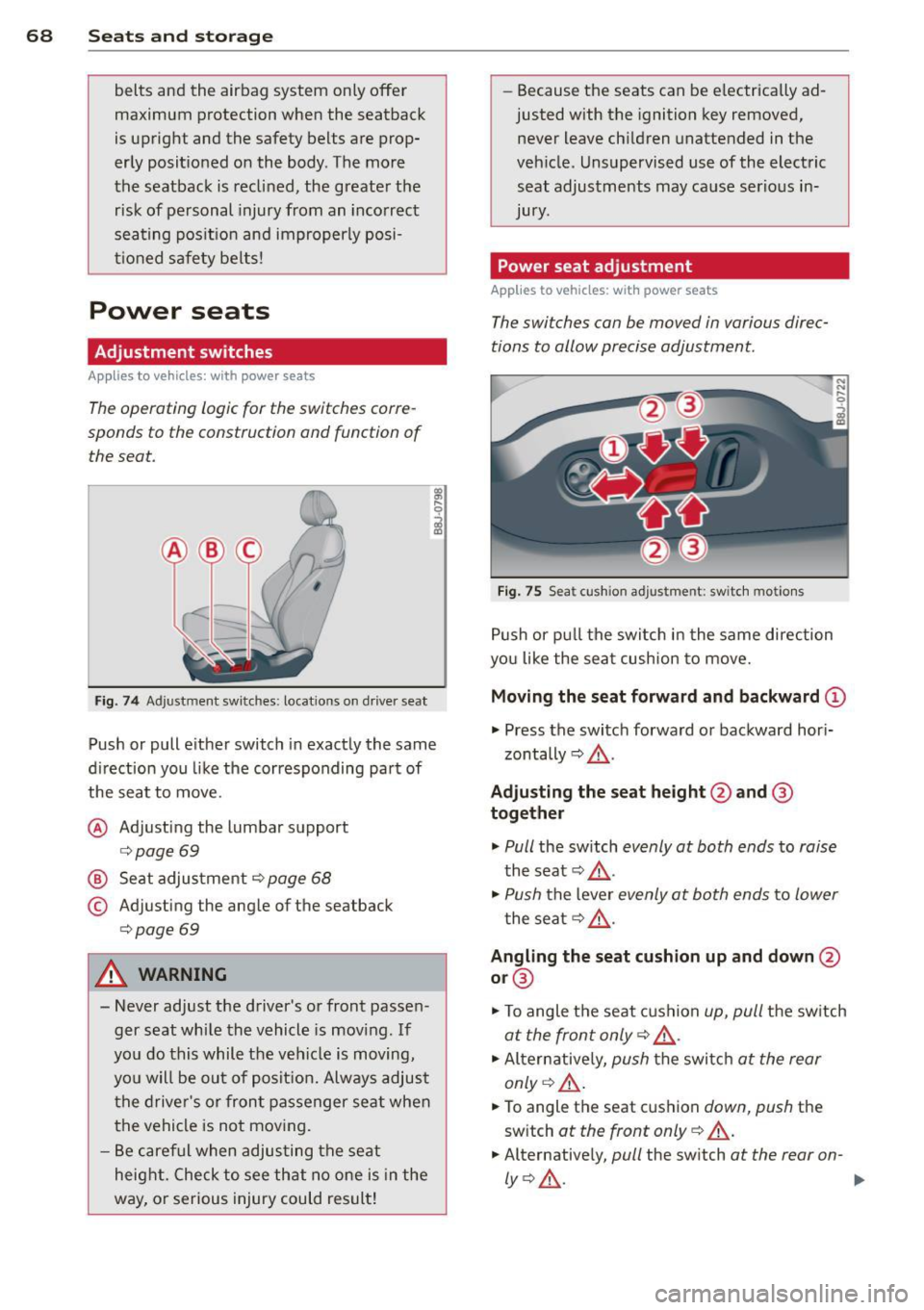
68 Seats and st o ra ge
belts and the airbag system only offe r
maximum protection when the seat back
is u pright and the safety belts are prop
erly positioned on the body . The more
the seatback is reclined, the greater the
risk of personal injury from an incorrect
seating pos it ion and improperly posi
t ioned s afety be lts!
Power seats
Adjustment switches
App lies to vehicles: with power seats
The operating logic for the switches corre
sponds to the construction and function of
the seat.
F ig . 7 4 Adju stm en t sw it c h es: locat io ns o n dr ive r seat
Push or pull e ither switch in exactly the same
d irection you like the corresponding part of
the seat to move.
@ Adjusting the lumba r support
¢ page 69
@ Seat adjus tment¢ page 68
© Adjusting the ang le of the seatback
¢ page 69
A WARNING
- Never adjust t he d river's o r front passe n
ger seat wh ile the vehicle is moving . If
yo u do this while t he veh icle is moving,
yo u will be ou t of posi tion. Always adjust
t h e dr ive r's or front passenger se at when
the vehicle is not mov ing.
- B e caref ul when adju sting t he seat
heig ht. Check to see that no one is in the
way, or serious injury could result! -
Because the seats can be e lectrically ad
justed with the ignition key removed,
never leave chi ldren unattended in the
veh icle . Unsupervised use of the electric
seat adjustments may ca use serio us in
Jury .
Power seat adjustment
Applies to vehicles: wit h power seats
The switches can be moved in various direc
tions to allow precise adjustment.
Fig. 75 Sea t cus hion ad ju st me nt: s wit c h m oti on s
P ush or p ull the switch i n the same direction
yo u like the sea t cushion to move.
Moving the seat forward and backward ©
.., Press the switc h forward or backward hor i-
zontally ¢& .
Adju sting the seat height@and @
together
.., Pull the sw itch evenly at both ends t o raise
the seat ¢ A.
.., Push the lever evenly at both ends to lower
t he sea t¢ & -
Angling the seat cushion up and down@
or @
.., To angle t he seat cushion up, pull the sw itch
at the fron t only ¢& .
.., Altern ative ly, push the switc h at the rear
only ¢& .
.., To angle the seat c ushion down, push the
sw itch
at the front only¢ A.
.., Alternative ly, pull the sw itch at the rear on-
ly ¢& . ....
Page 72 of 260
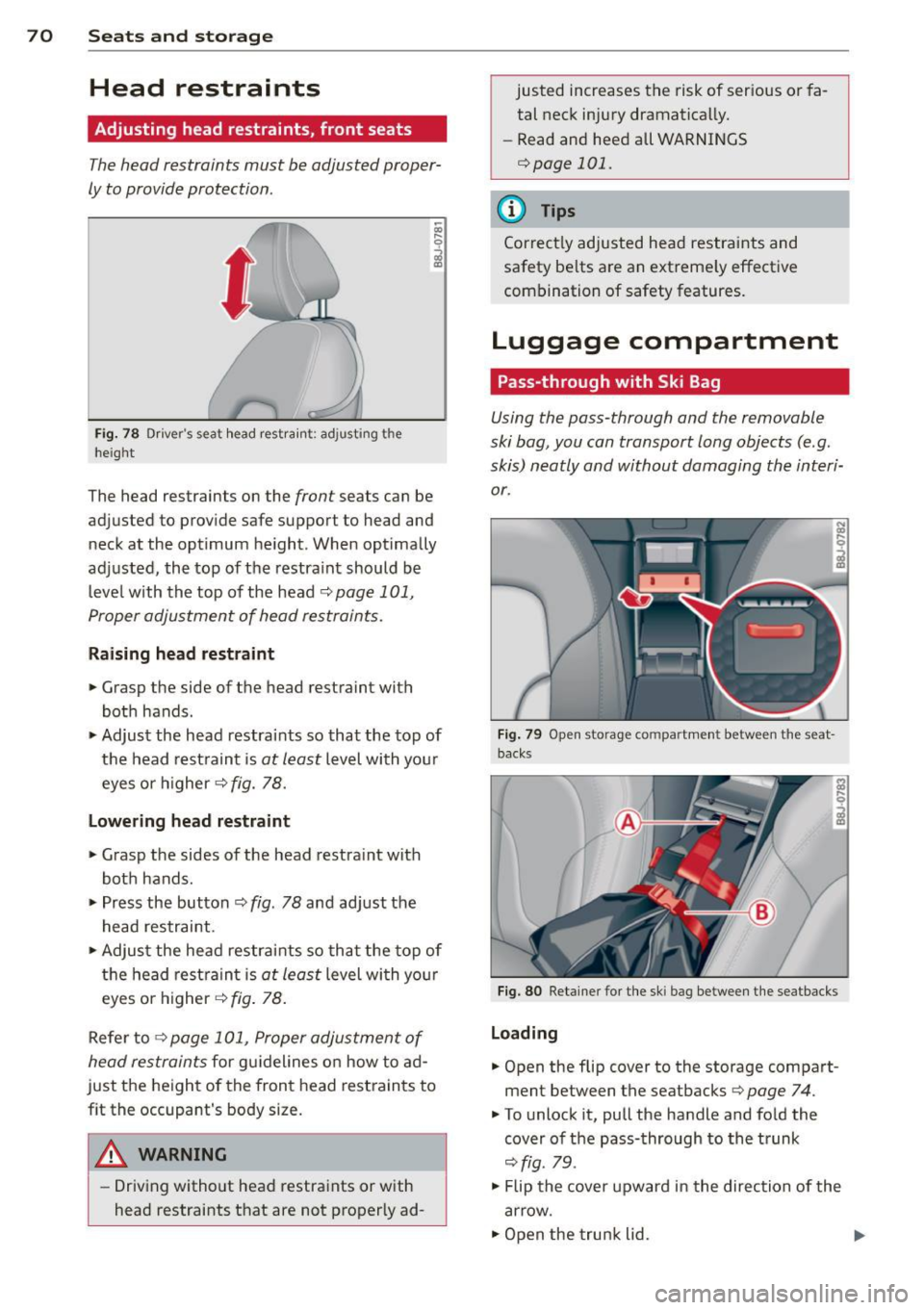
70 Seats and st o ra ge
Head restraints
Adjusting head restraints, front seats
The head restraints must be adjusted proper
ly to provide protection .
Fig. 78 Dr iver "s seat hea d restra int: ad justing the
height
The head restraints on the front seats can be
adjusted to prov ide safe support to head and
neck at the optimum he ight. When optimally
adjusted, the top of the restra int should be
leve l with the top of the head
qpage 101,
Proper adjustment of head restraints.
Raising head rest raint
• Grasp the side of the head restraint with
bot h hands.
• Adjust the head restra ints so that the top of
the head rest raint is
at l east level with you r
eyes or higher
qfig. 78.
Lowe ring head restraint
• Grasp the sides of the head restra int with
both hands.
• Press the button
q fig . 78 and adjust the
head restraint.
• Adjust the head restra ints so that the top of
t h e head restrain t is
at least level wi th you r
eyes or higher
q fig . 78 .
Refe r to q page 101, Proper adjus tment of
head restraints
for gu idelines o n how to ad
just the heigh t of the front head rest raints to
f it the occupa nt's body size.
&_ WARNING
- Driv ing witho ut head restra ints or with
head restraints that are not properly ad-
-
justed increases the risk of ser ious or fa
tal neck injury dramatica lly.
- Read and heed all WARNI NGS
qpage 101.
(D Tips
Correct ly adjusted head restraints and
safety be lts are an extreme ly effect ive
com bination of safety features.
Luggage compartment
Pass-through with Ski Bag
Using the pass-through and the removable
ski bag, you can transport long objects (e.g.
skis) neatly and without damaging the interi
or.
F ig. 79 Open sto rage compartment between the seat
backs
Fi g. 80 Reta iner fo r th e sk i bag betwee n the seatbacks
Loading
• Open the flip cover to the storage compart
ment between th e seatbacks
q page 7 4.
• To unlock it, pull the handle and fo ld the
cover of the pass-through to the t runk
qfig. 79.
"" Flip the cover upward in the direction of the
ar row.
• Open the tru nk lid.
Page 103 of 260

A WARNING 1-=
Front seat passengers who are unbelted,
out of position or too close to the airbag
can be seriously injured or killed by the air
bag as it unfolds. To help reduce the risk of
serious personal injury:
- Passengers must always sit in an upright
position and never lean against or place
any part of their body too close to the
area where the airbags are located.
- Passengers who are unbelted, out of po
sition or too close to the airbag can be
seriously injured by an airbag as it un
folds with great force in the blink of an
eye.
- Always make sure that there are at least
10 inches (25 cm) between the front
passenger's breastbone and the instru
ment panel.
- Always make sure that there are at least
4 inches (10 cm) between the front pas
senger's knees and the lower part of the
instrument panel.
- Each passenger must always sit on a seat of their own and properly fasten and
wear the safety belt belonging to that
seat .
- Before driving, always adjust the front
passenger seat and head restraint prop
erly .
- Always keep your feet on the floor in
front of the seat . Never rest them on the
seat, instrument panel, out of the win
dow, etc. The airbag system and safety
belt will not be able to protect you prop
erly and can even increase the risk of in
jury in a crash.
- Never drive with the backrest reclined or
tilted far back! The farther the backrests
are tilted back, the greater the risk of in
jury due to incorrect positioning of the safety belt and improper seating posi
tion.
- Children must always ride in child seats
c> page 136. Special precautions apply
when installing a child seat on the front
passenger seat
c> page 115.
Driving Safely 101
Proper adjustment of head restraints
Correctly adjusted head restraints are an im
portant part of your vehicle's occupant re straint system and can help to reduce the risk
of injuries in accident situations .
Fig. 109 Corre ctl y adju sted head restra int vi ewe d fro m
the side
The head restraints must be correctly adjust
ed to achieve the best protection.
.. Adjust the head restraint so that the upper
edge of the restraint is level with the top of
your head, but no lower than eye level and
so it is as close to the back of your head as
possible
c> fig . 109.
Adjusting head restraints c> page 70 .
A WARNING
Driving without head restraints or with
head restraints that are not properly ad
justed increases the risk of serious or fatal
neck injuriy dramatically . To help reduce
the risk of injury:
- Always drive with the head restraints in
place and properly adjusted.
- Every person in the vehicle must have a
properly adjusted head restraint.
- Always make sure each person in the ve
hicle properly adjusts their head re
straint. Each head restraint must be ad
justed according to occupants' size so that the upper edge is as even with the
top of the person's head, but no lower
than eye level and so it is as close to the
back of to the head as possible.
- Never attempt to adjust head restraint
while driving. If you have driven off and
•
•
Page 113 of 260
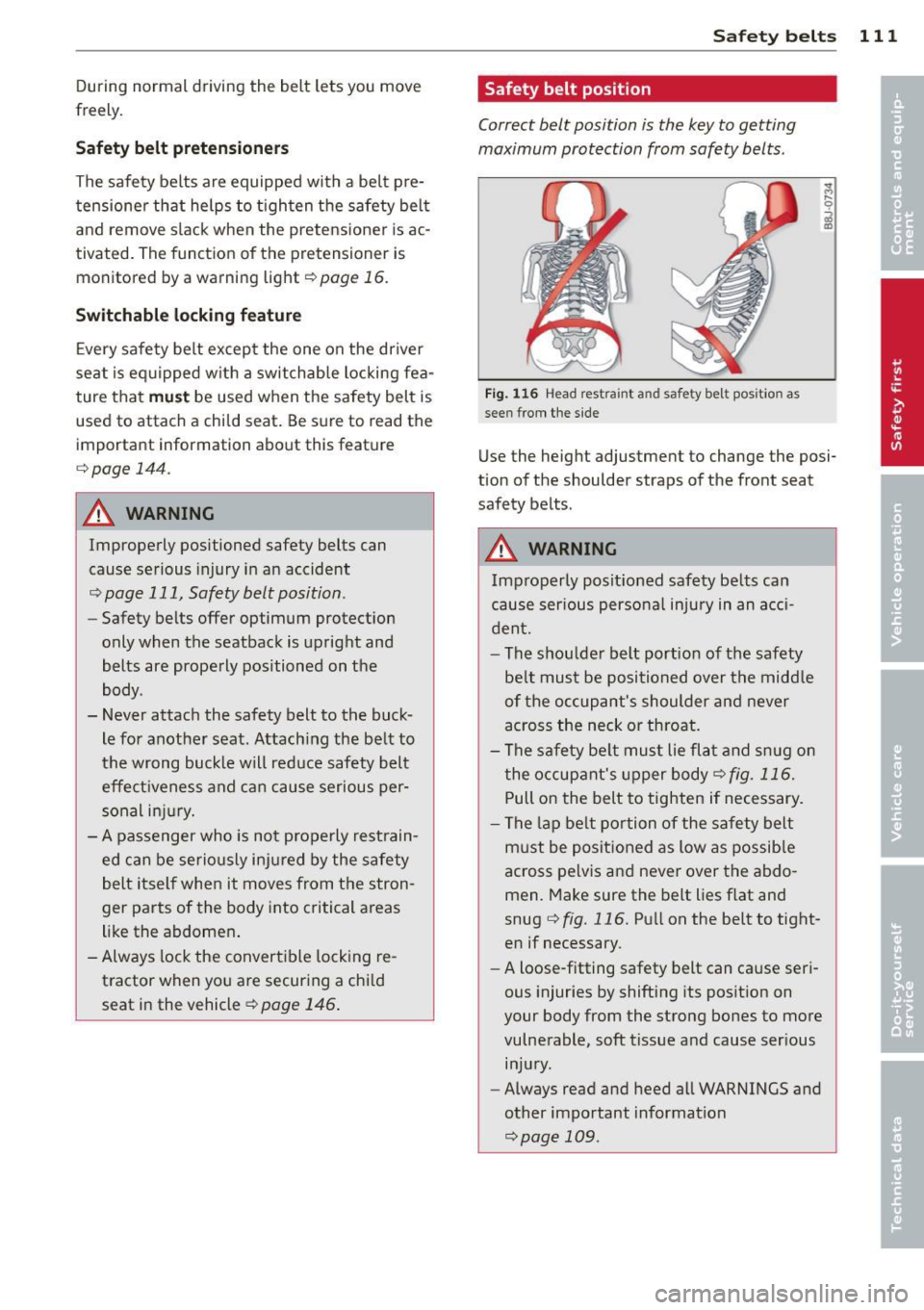
During normal driving the belt lets you move
freely.
Safety belt pretensioners
The safety belts are equipped with a belt p re
tensione r that helps to t igh ten the safety be lt
and remove s lack when the pretensione r is ac
tivated. The function of the pretensioner is monitored by a warning light
¢ page 16.
Switchable locking feature
Every safe ty belt excep t the one on the driver
seat is eq uipped w ith a switchab le locking fea
ture that
mu st be used when the safety belt is
used to attach a child seat . Be s ure to read the
important informat ion about th is f eature
c:;, page 144.
A WARNING
Improperly positioned safety belts can
cause serious injury in an accident
¢ page 111, Safety belt position .
-Safety belts offer optimum protection
only when the seatback is upright and
belts are properly positioned on the
body .
-
-Never attach the safety belt to the buck
le for another seat . Attach ing the belt to
the wrong buckle will reduce safety belt effect iveness and ca n cause seri ous per
sonal in jury.
- A passenger who is no t properly rest rain
ed can be se rio usly inju red by the safety
belt itself when it moves from the stron
ger parts of the body into critical areas
like the abdomen .
- Always lock the convert ible locking re
tractor when yo u are secur ing a chi ld
seat in the vehicle
c:;, page 146 .
Safety belts 111
Safety belt position
Correct belt position is the key to getting
maximum protection from safety belts .
Fig . 1 16 Head restra int a nd safety be lt pos it io n as
see n fr om t he side
Use the height adjustment to change the posi
tion of the shoulder straps of the fro nt seat
safety belts .
A WARNING
Imp roperly posit ioned safety be lts can
cause ser ious persona l injury in an acci
dent.
- The shou lder belt portion of the safety
be lt must be posi tioned over the midd le
of the occupant's shoulder and never
across the neck or throat.
- The safety be lt must lie fla t and sn ug on
the occupant's upper body¢
fig. 116.
Pull on the belt to tighten if necessary.
-
- The lap be lt po rtion of the safety belt
must be posit ioned as low as possib le
across pelvis and never over the abdo
men. Make sure the belt lies flat and
snug ¢
fig. 116 . Pull on the belt to tight
en if necessary .
- A loose-fitting safety belt can cause seri
ous injuries by shifting its pos it ion on
your body from the strong bones to more
vulne rable , soft tissue and cause ser ious
in jury .
- Always read and heed all WARNINGS and
other important information
¢page 109.
Page 117 of 260
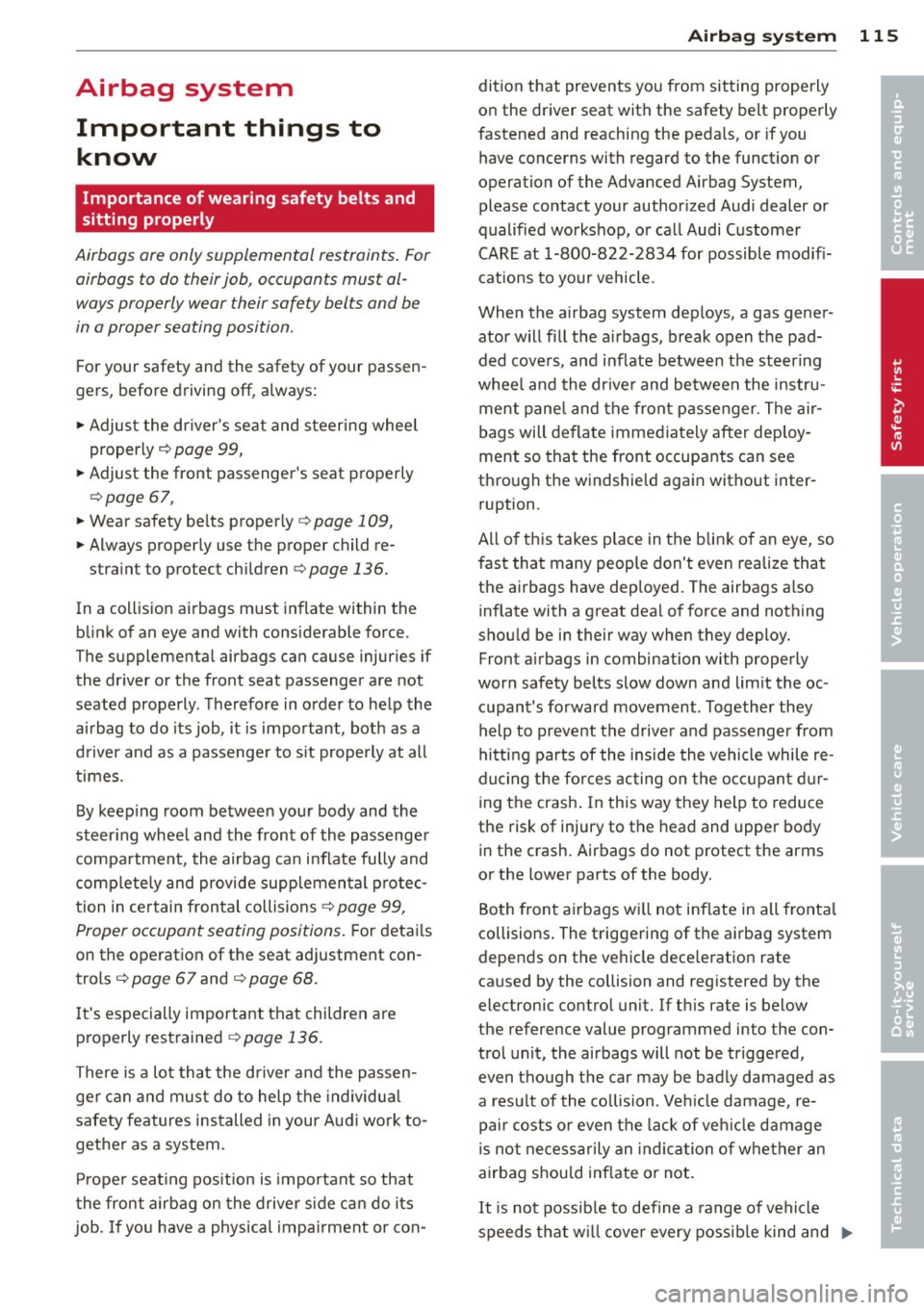
Airbag system Important things to know
Importance of wearing safety belts and
sitting properly
Airbags are only supplemental restraints. For
airbags to do their job , occupants must al
ways properly wear their safety belts and be
in a proper seating position.
For your safety and the safety of your passen
gers, before driving off, always:
""Adjust the driver's seat and steering wheel
properly ¢
page 99,
"" Adjust the front passenger's seat properly
¢page 67 ,
""Wear safety be lts properly r::::> page 109,
""Always properly use the proper child re-
straint to protect children
r::::> page 136.
In a collision airbags must inflate within the
blink of an eye and with considerable force.
The supplemental airbags can cause injuries if
the driver or the front seat passenger are not
seated properly . Therefore in order to help the
airbag to do its job, it is important, both as a
driver and as a passenger to s it properly at all
times.
By keeping room between your body and the
steering whee l and the front of the passenger
compartment, the airbag can inflate fully and
comp letely and provide supplemental protec
tion in certain frontal collisions
r::::> page 99,
Proper occupant seating positions. For details
on the operation of the seat adjustment con
trols ¢
page 67 and ¢ page 68.
It's especially important that children are
properly restrained
r::::> page 136.
There is a lot that the driver and the passen
ger can and must do to help the individua l
safety features installed in your Audi work to
gether as a system.
Proper seating pos ition is important so that
the front airbag on the driver side can do its
job. If you have a physical impairment or con-
Airbag system 115
dition that prevents you from sitting properly
on the driver seat with the safety belt properly
fastened and reaching the pedals, or if you
have concerns with regard to the function or
operation of the Advanced Airbag System,
please contact your authorized Audi dealer or
qualified workshop, or call Audi Customer
CARE at 1-800-822-2834 for possible modifi
cations to your vehicle .
When the airbag system dep loys, a gas gener
ator will fill the a irbags, break open the pad
ded covers, and inflate between the steer ing
wheel and the driver and between the instru
ment panel and the front passenger. The air
bags will deflate immediately after deploy
ment so that the front occupants can see
through the windshield again without inter
ruption.
All of this takes place in the blink of an eye, so
fast that many people don't even realize that
the airbags have deployed. The airbags a lso
inflate with a great dea l of force and nothing
should be in their way when they deploy.
Front airbags in combination with properly
worn safety belts slow down and limit the oc
cupant's forward movement. Together they
help to prevent the driver and passenger from
hitting parts of the inside the vehicle while re
ducing the forces acting on the occupant dur
ing the crash . In this way they help to reduce
the risk of injury to the head and upper body
in the crash. Airbags do not protect the arms
or the lower parts of the body.
Both front airbags wi ll not inflate in all fronta l
collisions . The triggering of the airbag system
depends on the vehicle dece leration rate
caused by the co llision and registered by the
electronic control unit. If this rate is below
the reference value programmed into the con
trol unit, the airbags will not be triggered,
even though the car may be badly damaged as
a result of the collision . Veh icle damage, re
pair costs or even the lack of veh icle damage
is not necessarily an indication of whether an
airbag should inf late o r not.
It is not possib le to define a range of vehicle
speeds that w ill cover every possible kind and ..,. •
•
Page 120 of 260
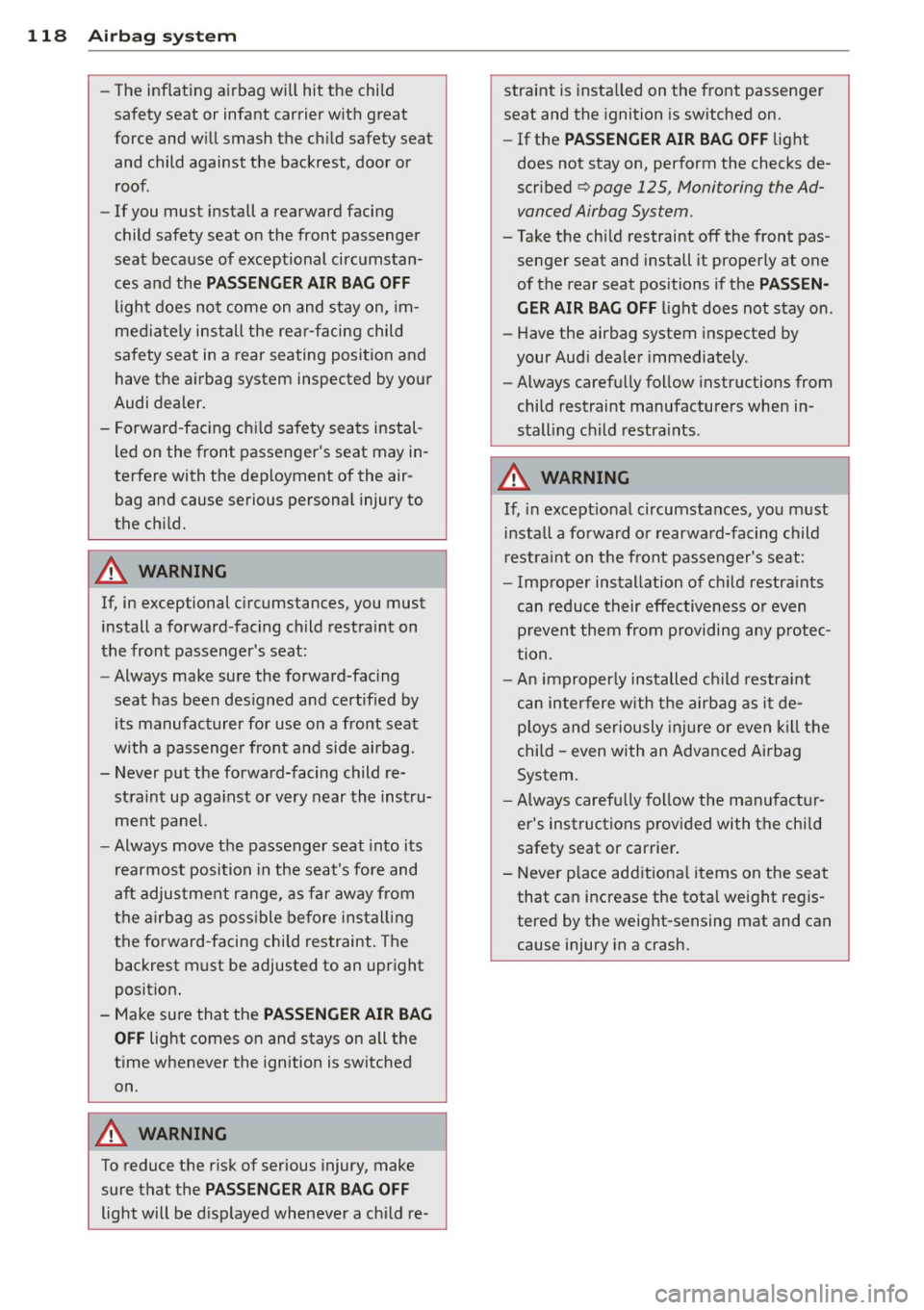
118 Airbag sys te m
- The inflati ng airba g will hit the child
safety seat or infant carrier w ith great
force and w ill smash the ch ild safety seat
and child against the backr est, door or
ro of.
- If you must install a rearwar d facing
child safety seat on the front passenger
seat b ecause of exceptional circ umstan
ces and the
PASSENGER AIR BAG OFF
light does not come on and stay on, im
med iately install the rea r-facing child
safety seat in a rear seating position and
have the a irbag system inspected by your
Audi dealer .
- Forward -fac ing ch ild safety seats instal
led on the front passenger's seat may in
terfere with the deployment of the air
bag and cause serious personal injury to
the ch ild.
A WARNING
If, in exceptional c ircumstances, you must
install a forward-facing child restra int on
the front passenger's seat
- Always make sure the forward-fac ing
seat has been des igned and certified by
its manufacturer for use on a front seat
with a passenger front and side airbag.
- Never put the forward-facing child re
straint up aga inst or very near the inst ru
me nt pane l.
- Always move the passenger seat into its
rearmost position in the seat 's fore and
aft adjustment range, as far away from
the a irb ag as poss ible be fore instal ling
the fo rward-facing child restraint. T he
backrest must be adjusted to an upright
position .
- Make su re that the
PASSENGER AIR BAG
OFF
light comes on and stays on all the
t ime whenever the ignition is switched
on.
A WARNING
To reduce the risk of serious injury, make
sure that the
PASSENGER AIR BAG OFF
light will be d isplayed whenever a ch ild re- straint is
insta lled on the front passenger
seat and the ignition is sw itched on.
- If the
PASSENGER AIR BAG OFF light
does not stay on, per form the checks de
scribed ¢
page 125, Monitoring the Ad
vanced Airbag System.
- Ta ke the chi ld restraint off the front pas
senger seat and install it properly at one
of the rear seat positions if the
PASSEN
GER AIR BAG OFF
l ight does not s tay on.
- Have the airbag system inspected by
your Aud i dea le r i mmediately .
- Always carefully follow instructions from
child restraint manufacture rs when in
stalling child restra ints.
A WARNING
=
If, in except ional circumstances, you m ust
i nsta ll a forward o r rearwa rd-facing child
r estra int on t he front passe nger's seat:
- Imp rope r installation of ch ild restra ints
can reduce their effectiv eness o r even
p reven t them from providing any protec
tion.
- An improperly installed ch ild restra int
can inter fere with the airbag as i t de
p loys and seriously inj ure o r even k ill the
child -even with an Advanced Airbag
System.
- Always carefu lly follow the manu fact ur
er 's instructions p rov ided with the chi ld
safety seat or carrier .
- Never p lace add itiona l items on the seat
that can increase the total weight reg is
tered by the weight-sensing mat and can
cause injury in a crash.
Page 139 of 260

A WARNING ,~
If, in exceptional circumstances, you must
install a forward-facing child restraint on
the front passenger's seat:
- Always make sure the forward-facing
seat has been designed and certified by
its manufacturer for use on a front seat
with a passenger front and side airbag.
-Always follow the manufacturer's in
structions provided with the child safety
seat or carrier.
- Always move the passenger seat into its
rearmost position in the seat's fore and
aft adjustment range, as far away from
the airbag as possible before installing
the child restraint. The backrest must be
adjusted to an upright position.
- Always make sure that the
PASSENGER
AIR BAG OFF light comes on and stays
on all the time whenever the ignition is
switched on.
Advanced front airbag system and children
Your vehicle is equipped with an "Advanced
Airbag System" in compliance with United
States Federal Motor Vehicle Safety Standard
(FMVSS) 208 as applicable at the time your
vehicle was manufactured.
The Advanced Airbag system in your vehicle
has been certified to meet the "low-risk" re
quirements for 3- and 6-year old children on
the passenger side and small adults on the
driver side. The low risk deployment criteria
are intended to reduce the risk of injury
through interaction with the airbag that can
occur, for example, by being too close to the
steering wheel and instrument panel when
the airbag inflates. In addition, the system has been certified to comply with the "sup
pression" requirements of the Safety Stand
ard, to turn
off the front airbag for infants up
to 12 months who are restrained on the front
passenger seat in child restraints that are list
ed in the Standard.
Child Safety 137
Even though your vehicle is equipped with an
Advanced Airbag system, a child should al
ways ride in theseat properly restrained for its
age and si ze . The airbag on the passenger side
makes the front seat a potentially dangerous
place for a child to ride . The front seat is not
the safest place for a child in a forward-facing
child safety seat . It can be a very dangerous
place for an infant or a larger child in a rear
ward-facing seat.
Advanced Airbags and the weight
sensing mat in the front seat
The Advanced Airbag System in your vehicle detects the presence of an infant or child in a
child restraint on the front passenger seat us
ing the weight -sensing mat in the seat cush
ion and the sensor below the safety belt latch
on the front passenger seat that measures the
tension on the safety belt.
The weight -sensing mat measures total
weight of the child and the child safety seat
and a child blanket on the front passenger
seat. The weight on the front passenger seat
is related to the design of the child restraint
and its "footprint", the size and shape of the
bottom of the child restraint as it sits on the
seat. The weight of a child restraint and its
"footprint" vary for different kinds of child re
straints and for the different models of the
same kind of child restraint offered by child
restraint manufacturers .
The weight ranges for the individual types,
makes and models of child restraints that the
NHTSA has specified in the Safety Standard
together with the weight ranges of typical in
fants and typical 1 year-old child have been
stored in the control unit of the Advanced Air
bag System. When a child restraint is being
used on the front passenger seat with a typi
cal 1 year-old child, the Advanced Airbag Sys
tem compares the weight measured by the
weight sensing mat with the information stor
ed in the electronic control unit.
The electronic control unit also registers the
tension on the front passenger safety belt. ..,. •
•
Page 142 of 260

140 Child Safety
,8. WARNING ,~
Not using a child safety seat, using the
wrong child safety seat or improperly in
stalling a child restraint increases the risk
of serious personal injury and death .
-All vehicle occupants and especially chil
dren must always be restrained properly
whenever riding in a vehicle.
-
- An unrestrained or improperly restrain
ed child can be injured or killed by be
ing thrown against the inside of the ve
hicle or by being ejected from it during
a sudden maneuver or impact .
- An unrestrained or improperly restrain
ed child is at much greater risk of injury
or death by being struck by an inflating
airbag.
- Commercially available child safety seats
are required to comply with U.S. Federal
Motor Vehicle Safety Standard (FMVSS)
213 (in Canada CMVSS 213).
- When buying a child restraint, select
one that fits your child and the vehicle.
- Only use child restraint systems that
fully contact the flat portion of the
seat cushion. The child restraint must not tip or lean to either side. Audi does
not recommend using child safety
seats that rest on legs or tube -like
frames . They do not provide adequate
contact with the seat.
-Always heed all legal requirements per
taining to the installation and use of
child safety seats and carefully follow
the instructions provided by the manu
facturer of the seat you are using.
- Never let more than one child occupy a
child safety seat .
- Never let babies or older children ride in
a vehicle while sitting on the lap of an-
other passenger.
- Holding a child in your arms is never a
substitute for a child restraint system.
- The strongest person could not hold the child with the forces that exist in
an accident . The child will strike the in-terior of the vehicle and can also be
struck by the passenger.
- The child and the passenger can also
injure each another in an accident.
- Never install a rearward facing child
safety seat on the front passenger seat
unless the
PASSENGER AIR BAG OFF
light comes on and stays on. If the PAS
SENGER AIR BAG OFF
light does not
come on and stay on the inflating airbag
will hit the child safety seat or infant car rier with great force and will smash the
child safety seat and child against the
backrest, door or roof. Have the airbag
system inspected immediately by your
Audi dealer.
- Forward-facing child safety seats instal
led on the front passenger's seat can in
terfere with the airbag when it inflates
and cause serious injury to the child.
- If exceptional circumstances require the
use of a forward-facing child restraint on
the front passenger's seat, the child's
safety and well-being require that the
following special precautions be taken :
- Make sure the forward-facing seat has
been designed and certified by its man
ufacturer for use on a front seat with a
passenger front and side airbag.
- Always carefully follow the manufac
turer's instructions provided with the
child safety seat or carrier.
- Always move the front passenger seat into the rearmost position of the pas
senger seat's fore and aft adjustment
range, and as far away from the airbag
as possible before installing the child
restraint .
- Always make sure that nothing pre
vents the front passenger's seat from
being moved to the rearmost position
in its fore and aft adjustment range .
- Always make sure that the backrest is
in the upright position .
- Always buckle the child safety seat firmly
in place even if a child is not sitting in it.
A loose child safety seat can fly around
during a sudden stop or in a collision.
~